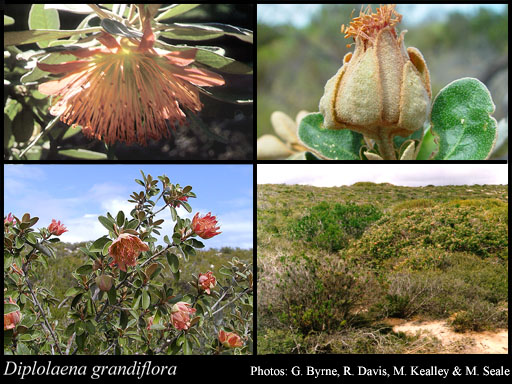- Reference
- Mém.Mus.Hist.Nat. 3:451 (1817)
- Conservation Code
- Not threatened
- Naturalised Status
- Native to Western Australia
- Name Status
- Current
Erect, spreading shrub, 0.5-3 m high, leaves elliptic, outer involucral bracts broadly ovate, inner bracts more or less equal to stamens. Fl. pink-red, May to Oct. Sand. Limestone outcrops & ridges, sand dunes.

Scientific Description
Shrub, spines absent; branchlets smooth, without distinct raised glands, +/- cylindrical in cross-section, covered in hairs or scales, the hairs stellate (star-shaped). Leaves alternate, simple, 30-45 mm long, 10-15 mm wide, flat, the margins flat, smooth, without distinct raised glands, covered in hairs or scales, with stellate (star shaped) hairs; stipular excrescences absent. Flowers in a distinct head surrounded by bracts, the outer bracts 12-16 mm long; pedicels 8-12 mm long; calyx minute or absent, smooth, without distinct raised glands; corolla red or pink, petals five, 5-6.5 mm long, imbricate (overlapping), free, glabrous; stamens numerous (more than twice as many as petals), 18-20 mm long, smooth, hairy; anthers 1.2-1.5 mm long, without an appendage. Flowers in May, June, July, August, September and October. Occurs in the Eremaean and South-West Botanical Province, in the Carnarvon, Yalgoo and Geraldton IBRA region(s).
Distribution
- IBRA Regions
- Carnarvon, Geraldton Sandplains, Yalgoo.
- IBRA Subregions
- Cape Range, Edel, Geraldton Hills, Wooramel.
- IMCRA Regions
- Abrolhos Islands, Central West Coast, Shark Bay, Zuytdorp.
- Local Government Areas (LGAs)
- Carnarvon, Chapman Valley, Exmouth, Greater Geraldton, Northampton, Shark Bay.